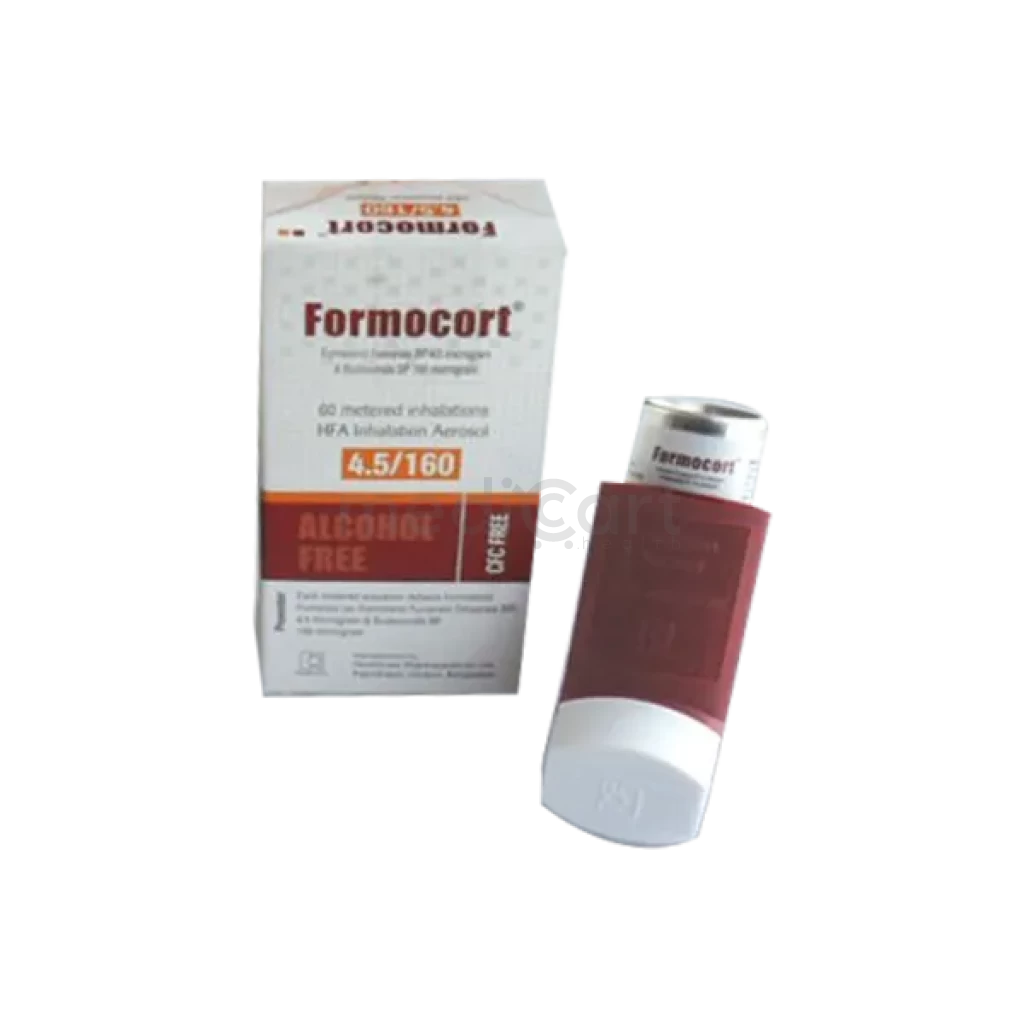

Formocort MDI 4.5/80
Inhalation* Delivery will be done in Dhaka city only.
Alternative Product
More Information About - Formocort MDI 4.5/80
Description
Generic Name
Budesonide + Formoterol Fumarate
Precaution
Treatment with Budesonide and Formoterol combination should not be initiated to treat a severe exacerbation or if patients have significantly worsening or acutely deteriorating asthma. May produce paradoxical bronchospasm which is life-threatening. Caution when used in patients with CV diseases, especially coronary insufficiency, cardiac arrhythmias and hypertension. Chronic use may further decrease bone mineral content when used in patients with advanced age, osteoporosis, poor nutrition, sedentary lifestyle or tobacco use. May reduce growth velocity when used in paediatric patients. Caution when used in patients with active or quiescent tuberculosis infection of the respiratory tract, untreated systemic fungal, bacterial, viral or parasitic infections, or ocular herpes simplex. Pregnancy and lactation. Lactation: No data; weigh risks of therapy against benefits, and either discontinue drug or do not nurse
Indication
Asthma, COPD
Contra Indication
Primary treatment of status asthmaticus or other acute episodes of asthma. Hypersensitivity to Budesonide, Formoterol or to Lactose.
Dose
N/A
Side Effect
>10% Upper respiratory tract infection (URTI) (8-11%),Headache (7-11%),Nasopharyngitis (7-11%) 1-10% Pharyngolaryngeal pain (6-9%),Stomach discomfort (1-7%),Sinusitis (5-6%),Oral candidiasis (1-6%),Bronchitis (5%),Viral URTI (4%),Backache (2-3%),Influenza (2-3%),Nasal congestion (2-3%),Vomiting (1- 3%)
Pregnancy Category
Name : Not Classified
Description
FDA has not yet classified the drug into a specified pregnancy category.Mode of Action
Budesonide is a corticosteroid that has mainly glucocorticoid activity. It prevents and controls inflammation by controlling the rate of protein syntheis, decreasing the migration of polymorphonuclear leucocytes/fibroblasts and reversing capillary permeability. Formoterol fumarate is a selective beta2-adrenergic agonist. It causes bronchodilation by catalysing the conversion of adenosine triphosphate to cyclic-3', 5'-adenosine monophosphate (cyclic AMP) resulting in bronchial smooth muscle relaxation.
Interaction
Concomitant admin with CYP3A4 inhibitor e.g. itraconazole, clarithromycin, erythromycin may inhibit the metabolism of budesonide. Concurrent use with nonpotassium-sparing diuretics may lead to ECG changes and/or hypokalaemia.
Pregnancy Category Note
Pregnancy In women with poorly or moderately controlled asthma, there is increased risk of several perinatal adverse outcomes such as preeclampsia in the mother and prematurity, low birth weight, and small for gestational age in neonate; pregnant women with asthma should be closely monitored and medication adjusted as necessary to maintain optimal asthma control There are no well-controlled human studies that have investigated the effects of therapy during labor and delivery; because of potential for beta-agonist interference with uterine contractility, use of therapy during labor should be restricted to those patients in whom the benefits clearly outweigh risk Lactation There are no available data on the breastfed child or on milk production; budesonide, like other inhaled corticosteroids, is present in human milk; there are no available data on the presence of formoterol fumarate in human milk; formoterol fumarate is present in rat milk; the developmental and health benefits of breastfeeding should be considered along with the mother’s clinical need for therapy and any potential adverse effects on the breastfed infant from therapy or from underlying maternal condition
Adult Dose
Asthma Maintenance and reliever therapy: Adults and adolescents (12 years and older) - As both maintenance and reliever therapy: Adults and adolescents (12 years and older): The recommended maintenance dose is 1 puff twice daily or 2 puffs once daily. For some patients a maintenance dose of 2 puffs twice daily may be appropriate (for 160/4.5 mcg/inhalation only). Patients should take 1 additional puff as needed in response to symptoms. If symptoms persist after a few minutes, the additional puff should be taken. Not more than 6 puffs should be taken on any single occasion. Convicap/cozycap: Maintenance dose: 100 Convicap twice daily. 200 Convicap twice daily. Reliever dose: 1 additional Convicap as needed in response to symptoms. If symptoms persist after a few minutes, an additional Convicap should be taken. COPD 200 Convicap: 2 Convicaps twice daily. 400 Convicap: 1 Convicap twice daily
Child Dose
<12 years: Safety and efficacy not established
Renal Dose
N/A
Administration
N/A
Disclaimer
The information provided herein are for informational purposes only and not intended to be a substitute for professional medical advice, diagnosis, or treatment. Please note that this information should not be treated as a replacement for physical medical consultation or advice. Great effort has been placed to provide accurate and comprehensive data. However, Medicart along with its authors and editors make no representations or warranties and specifically disclaim all liability for any medical information provided on the site. The absence of any information and/or warning to any drug shall not be considered and assumed as an implied assurance of the Company.








